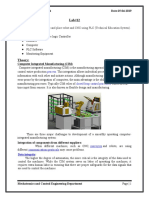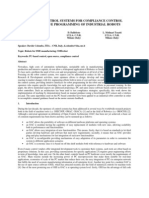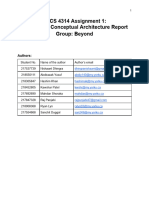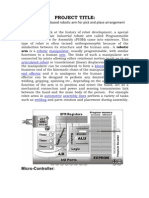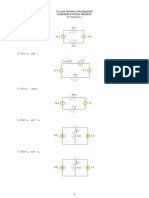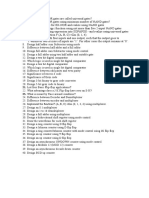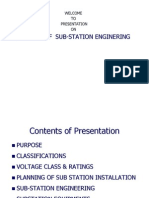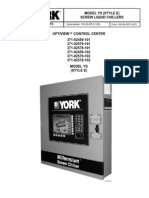Introduction To Motion Control Technology
Introduction To Motion Control Technology
Uploaded by
Akshaya AgarwalCopyright:
Available Formats
Introduction To Motion Control Technology
Introduction To Motion Control Technology
Uploaded by
Akshaya AgarwalOriginal Title
Copyright
Available Formats
Share this document
Did you find this document useful?
Is this content inappropriate?
Copyright:
Available Formats
Introduction To Motion Control Technology
Introduction To Motion Control Technology
Uploaded by
Akshaya AgarwalCopyright:
Available Formats
INTRODUCTION TO MOTION CONTROL TECHNOLOGY
Many different components are used in a variety of combinations to create a complete motion control or positioning system. Market offers the broadest range of products spanning the complete spectrum from mechanical actuators to micro stepping and brushless servo drives to programmable motion controllers. A successful application depends on choosing the right combination of actuator, motor, drive, and control technology. More than one technology may meet the requirements of your application. In this case, factors Such as performance, cost, flexibility, and simplicity may determine your selection.
Since human society entered the industrial age in the 18th century, motion control, especially precision motion control, has steadily gathered attention in terms of research, development and its application to produce innovation. Precision motion control, in electronic terms, means to accurately control the movement of an object based on speed, distance, load, inertia or a combination of all these factors. Driven by the requirements for much higher product performance, higher reliability, longer life and lower cost, numerous advances have been made recently, especially with the help of digital computers. With the emergence of Nano science at the end of the last century, technology in this field advanced a higher level. Today, high precision motion control has become an essential requirement in advanced manufacturing systems such as machine tools, micromanipulators, surface mounted robots, etc.
Generally, motion control systems can be separated into several parts: The mechanical device being moved, the motor (ac servo) with or without feedback, motion control I/O, motor driver, intellectual controller unit, and programming/operating interface software. Traditional motion control systems utilize PLC technology to fulfil the control task which typically comprises a number of hardware and software elements: PC for process visualization, hard PLC with coprocessor cards, I/O via field bus, motion control via parallel cabling and a selection of software operating systems and programming languages.
OBJECTIVE
The basic objective of the project is to design a three axis motion control system using three ac servo motors synchronized with each other for the purpose of pick and place system interfacing with PLC (Programmable Logic Controller). For example: pick and place motion system used in warehouses or stockyards for the proper management of inventory. The hardware of the system is being designed using pneumatic system principles and they are being controlled through actuators which are being operated through ladder logics supported on RS LOGIX 5000 software.
DESCRIPTION OF THE PROJECT
Our project is concerned with the object handling (or pick and place system)used in various environments where a three axis motion is required, for the management of various objects which are required in any industry like medical,automation,agriculture.etc. This whole system would be designed on the ladder logic software which will work on ALLEN BRADLEY PLC. The actuation of the three motors in a well-defined and co-ordinated sequence for the purpose of pick and place the job with the combination of the sliding rods. The PLC will be interfaced with servomotors synchronized with each other for the purpose of pick and place system. The modelling of the hardware would be done using Simulation software like SOLIDWORKS / PRO-E .
REFERENCES [1] The official web site of www.motioncontrol.com www.motioncontrolsystems.inc www.crazyengineers.com [2] PLC THEORY BOOK BY JAMES.E.MARTIN
You might also like
- Instrucciones de Servicio P50.Document23 pagesInstrucciones de Servicio P50.Erick Espinosa100% (1)
- Electrical Design Analysis (Oppo Ayale Feliz) ) Dec. 21,2017Document5 pagesElectrical Design Analysis (Oppo Ayale Feliz) ) Dec. 21,2017Angelica Tungpalan Domingo100% (2)
- PLC Based Industrial Conveyor Automation andDocument6 pagesPLC Based Industrial Conveyor Automation andiaetsdiaetsdNo ratings yet
- Lift Control System Based On PLCDocument3 pagesLift Control System Based On PLCrahul sharmaNo ratings yet
- Anufacturing EWS: Integrated Motion ControlDocument3 pagesAnufacturing EWS: Integrated Motion ControlSilvia_282008roNo ratings yet
- Programmable 5 Axis Robotic Arm: Aug, 2008 ProjectDocument38 pagesProgrammable 5 Axis Robotic Arm: Aug, 2008 ProjectRehman ZahidNo ratings yet
- TIA Unit 1-1Document21 pagesTIA Unit 1-1pawan826004No ratings yet
- Motion Control HandbookDocument38 pagesMotion Control Handbookvincentttt100% (1)
- Lab 12 Industrial AutomationDocument4 pagesLab 12 Industrial AutomationMuhammad UmarNo ratings yet
- National Institute of Technology, Kurukshetra Haryana: Submitted To Submitted byDocument31 pagesNational Institute of Technology, Kurukshetra Haryana: Submitted To Submitted byÄkshãy SaçhånNo ratings yet
- PLC Scada Training ReportDocument31 pagesPLC Scada Training ReportÄkshãy SaçhånNo ratings yet
- Simulation and Implementation of PLC Based For Detecting Burned Potato Chips and Remove Using PLCSIM and HMIDocument6 pagesSimulation and Implementation of PLC Based For Detecting Burned Potato Chips and Remove Using PLCSIM and HMIEditor IJTSRDNo ratings yet
- Application of Mobile Agents in Process Automation: U.Megalatha, Dr.P.E.SankaranarayananDocument6 pagesApplication of Mobile Agents in Process Automation: U.Megalatha, Dr.P.E.SankaranarayananMegalatha UmakanthanNo ratings yet
- SCADA - Automation - System - Laboratory - Elements - and - Applications - SiemensDocument6 pagesSCADA - Automation - System - Laboratory - Elements - and - Applications - SiemensNessieNo ratings yet
- The PLC in Automation TechnologyDocument22 pagesThe PLC in Automation TechnologyAthira AnandNo ratings yet
- 198 202 PDFDocument5 pages198 202 PDFMOBA THÁI NGUYÊNNo ratings yet
- Gagan 4th Year Report Main PartDocument25 pagesGagan 4th Year Report Main Partyogessh kumawatNo ratings yet
- Lab Manual: MCT-334L Industrial AutomationDocument38 pagesLab Manual: MCT-334L Industrial AutomationAhmed ChNo ratings yet
- Lab Manual: MCT-334L Industrial AutomationDocument24 pagesLab Manual: MCT-334L Industrial AutomationAhmed ChNo ratings yet
- Hybrid VehicleDocument4 pagesHybrid VehicleHoàng Sơn VũNo ratings yet
- Colombo Et Al ISR-Robotik06Document12 pagesColombo Et Al ISR-Robotik06Ravikumar NagulaNo ratings yet
- Moog Controllers MotionControllers Catalog enDocument68 pagesMoog Controllers MotionControllers Catalog enKamillAL-akhras100% (1)
- CMXR Robot Controller New: Motion Control For Multi-Axis SystemsDocument2 pagesCMXR Robot Controller New: Motion Control For Multi-Axis Systemsrimce77No ratings yet
- Design and Implementation of Elevator Using VHDLDocument3 pagesDesign and Implementation of Elevator Using VHDLKalyan Srivatsav0% (1)
- Autonomous Guided Vehicles: Submitted by Sidharthan S Roll - No 31Document10 pagesAutonomous Guided Vehicles: Submitted by Sidharthan S Roll - No 31Nauraa JeenaNo ratings yet
- Control Engineering and Automation LD PDF CatalogueDocument100 pagesControl Engineering and Automation LD PDF CatalogueIvan David SmithNo ratings yet
- Apartment Automation and Security System Using PLCDocument5 pagesApartment Automation and Security System Using PLCMengistu BirukeNo ratings yet
- PLC & HMI Interfacing For AC Servo Drive: Naveen Kumar E T.V.Snehaprabha Senthil KumarDocument5 pagesPLC & HMI Interfacing For AC Servo Drive: Naveen Kumar E T.V.Snehaprabha Senthil KumarNay Ba LaNo ratings yet
- BrunoDocument36 pagesBrunomansi567.kyNo ratings yet
- 6 v. D. CongDocument11 pages6 v. D. CongcodienttNo ratings yet
- RoboticsDocument32 pagesRoboticsNimmagaddadeepakNo ratings yet
- Monitoring and Control of A Variable Frequency Drive Using PLC and SCADADocument7 pagesMonitoring and Control of A Variable Frequency Drive Using PLC and SCADAEditor IJRITCCNo ratings yet
- Number SixDocument19 pagesNumber SixTolichoNo ratings yet
- Implementation of A High Performance Stand-Alone Motion ControllerDocument5 pagesImplementation of A High Performance Stand-Alone Motion ControllerBook4AllNo ratings yet
- Paper Roller PowerpointDocument17 pagesPaper Roller PowerpointMyo MinNo ratings yet
- An Application of NI SoftMotion RT System in A Motion Control WorkbenchDocument10 pagesAn Application of NI SoftMotion RT System in A Motion Control Workbenchggao20155No ratings yet
- LV RIO Elevator ControlDocument55 pagesLV RIO Elevator Control石大明No ratings yet
- Introduction To MechatronicsDocument6 pagesIntroduction To Mechatronicschileshelombe0No ratings yet
- Automatizare Macarale-31-45Document15 pagesAutomatizare Macarale-31-45alin grecuNo ratings yet
- Number 6Document19 pagesNumber 6TolichoNo ratings yet
- Document 3Document2 pagesDocument 3Teja TejaNo ratings yet
- 1.1. A Sense of HistoryDocument8 pages1.1. A Sense of HistoryCarlitos FerNo ratings yet
- Industrial AutomationDocument18 pagesIndustrial AutomationBILLYNo ratings yet
- Term PaperDocument9 pagesTerm PaperJake YaoNo ratings yet
- 7 Ncriet PDFDocument5 pages7 Ncriet PDFAndNo ratings yet
- Eecs 4314 Conceptual Architecture ReportDocument15 pagesEecs 4314 Conceptual Architecture Reportapi-723823461No ratings yet
- PLC PDFDocument9 pagesPLC PDFloganathan sNo ratings yet
- Conveyor Belt Motor Using Control Grafcet As Programming ToolDocument27 pagesConveyor Belt Motor Using Control Grafcet As Programming Toolcacung100% (3)
- 06 - Virtual Commissioning With Process Simulation TecnomatixDocument10 pages06 - Virtual Commissioning With Process Simulation TecnomatixjanardhanaNo ratings yet
- Design of A SCADA Graphical User Interface For An Industrial ProcessDocument5 pagesDesign of A SCADA Graphical User Interface For An Industrial ProcessvighneshNo ratings yet
- Scada PLC HmiDocument4 pagesScada PLC HmiM. S. ChikkamaniNo ratings yet
- Scada PaperDocument6 pagesScada PaperhafizgNo ratings yet
- Development of A Traffic Light Ontroller System Using PLCDocument26 pagesDevelopment of A Traffic Light Ontroller System Using PLCTimuçin Çakırgil50% (4)
- Mechatronics Question Bank - Key - Docx-1Document24 pagesMechatronics Question Bank - Key - Docx-1shaltan mandaNo ratings yet
- Control Systems: Government Polytechnic Channapatna Department of Mechanical EngineeringDocument39 pagesControl Systems: Government Polytechnic Channapatna Department of Mechanical EngineeringJunaid Ulla KhasimNo ratings yet
- Project Title...Document7 pagesProject Title...Abhishek ShahNo ratings yet
- Advances in Motion Sensing and Control for Robotic Applications: Selected Papers from the Symposium on Mechatronics, Robotics, and Control (SMRC’18)- CSME International Congress 2018, May 27-30, 2018 Toronto, CanadaFrom EverandAdvances in Motion Sensing and Control for Robotic Applications: Selected Papers from the Symposium on Mechatronics, Robotics, and Control (SMRC’18)- CSME International Congress 2018, May 27-30, 2018 Toronto, CanadaFarrokh Janabi-SharifiNo ratings yet
- The Age of Machines: A Comprehensive Overview of Robotics and Automation Technology"From EverandThe Age of Machines: A Comprehensive Overview of Robotics and Automation Technology"No ratings yet
- PLC Programming Using RSLogix 500 & Industrial Applications: Learn ladder logic step by step with real-world applicationsFrom EverandPLC Programming Using RSLogix 500 & Industrial Applications: Learn ladder logic step by step with real-world applicationsRating: 5 out of 5 stars5/5 (1)
- Mastering Siemens S7: A Comprehensive Guide to PLC ProgrammingFrom EverandMastering Siemens S7: A Comprehensive Guide to PLC ProgrammingNo ratings yet
- Franchisee AgrementDocument15 pagesFranchisee AgrementAkshaya AgarwalNo ratings yet
- Advertisement For Empanelment of Legal Counsel in NCVETDocument6 pagesAdvertisement For Empanelment of Legal Counsel in NCVETAkshaya AgarwalNo ratings yet
- Generation of Electricity From Speed BreakerDocument13 pagesGeneration of Electricity From Speed BreakerAkshaya AgarwalNo ratings yet
- Payment FormDocument2 pagesPayment FormAkshaya AgarwalNo ratings yet
- AKG00346Document12 pagesAKG00346Akshaya AgarwalNo ratings yet
- Yaks HaDocument2 pagesYaks HaAkshaya AgarwalNo ratings yet
- Tutorial 1Document1 pageTutorial 1sreekanthaNo ratings yet
- OES 4 Second Edition May 1989Document4 pagesOES 4 Second Edition May 1989kannanrk1984No ratings yet
- Servovalve Andritz HydroDocument4 pagesServovalve Andritz HydroYhony Gamarra VargasNo ratings yet
- Lab Reference QuestionsDocument5 pagesLab Reference QuestionsSumaya ShinosNo ratings yet
- I2c SlaveDocument4 pagesI2c SlaveSriramNo ratings yet
- Fujitsu Siemens Amilo Pro v3515 Sti Is1462 Fic lm10w Rev 0.7 SCH PDFDocument55 pagesFujitsu Siemens Amilo Pro v3515 Sti Is1462 Fic lm10w Rev 0.7 SCH PDFabhilashvaman5542No ratings yet
- 07-LTE-Vodafone Training PDFDocument30 pages07-LTE-Vodafone Training PDFAmine InpticNo ratings yet
- Automatic Plant Water Moistering System For GardenDocument4 pagesAutomatic Plant Water Moistering System For Gardenieee4mybusinessonlyNo ratings yet
- EC40EB Cabinet Product DescriptionDocument28 pagesEC40EB Cabinet Product DescriptionLawas Unik100% (1)
- Dspic 30Document248 pagesDspic 30ariel_cacciaNo ratings yet
- ZTE 2G Handover Algorithm: Why Do We Need Handover ?Document37 pagesZTE 2G Handover Algorithm: Why Do We Need Handover ?syrish2622No ratings yet
- RENR4343Document2 pagesRENR4343Cecilia Gomez.contrerasNo ratings yet
- Electrical Safety Standards For LVDocument10 pagesElectrical Safety Standards For LVmeshahanNo ratings yet
- Substation EngineeringDocument98 pagesSubstation EngineeringNilima Nautiyal92% (12)
- Generation, Transmission, & Distribution (OPTIONAL) ResourcesDocument1 pageGeneration, Transmission, & Distribution (OPTIONAL) Resourceszaheeruddin_mohdNo ratings yet
- NR - User Equipment Radio Transmission & ReceptionDocument234 pagesNR - User Equipment Radio Transmission & ReceptionAbhijeet BNo ratings yet
- RA Series Transfer Switches: Specification SheetDocument4 pagesRA Series Transfer Switches: Specification SheetjechurchNo ratings yet
- Li-Ion Battery & Charger Time Reference, Compatibility ChartDocument1 pageLi-Ion Battery & Charger Time Reference, Compatibility Charthamidin_syarifNo ratings yet
- Kimmon KP 2014 ManualDocument44 pagesKimmon KP 2014 ManualSubdriverNo ratings yet
- 160.80-RP3!3!07 YS Style E Optiview Control CenterDocument12 pages160.80-RP3!3!07 YS Style E Optiview Control CenterCheetah JimNo ratings yet
- Molex Ethernet Cable PDFDocument1 pageMolex Ethernet Cable PDFK Vinoth ShivanNo ratings yet
- Marcus Retro 01Document7 pagesMarcus Retro 01cphilpott1971No ratings yet
- Radio Frequency IdentificationDocument16 pagesRadio Frequency IdentificationPinkal PatelNo ratings yet
- Dual, Low Noise, Wideband Variable Gain Amplifiers AD600/AD602Document32 pagesDual, Low Noise, Wideband Variable Gain Amplifiers AD600/AD602Edward RamirezNo ratings yet
- Application of SuperconductorDocument28 pagesApplication of SuperconductorManu JainNo ratings yet
- GE-Challenges and Lessons Learned From The Design and Implementation of An IEC 61850-90-5 Based Synchrophasor System-Georgia Tech Conference (GOOD)Document10 pagesGE-Challenges and Lessons Learned From The Design and Implementation of An IEC 61850-90-5 Based Synchrophasor System-Georgia Tech Conference (GOOD)Gustavo AguayoNo ratings yet
- Uncle Harvey's Guide To Leslie Pin-OutsDocument4 pagesUncle Harvey's Guide To Leslie Pin-Outsjimmyd0% (1)
- Problemas ExamenDocument34 pagesProblemas Examenmayki67% (3)








